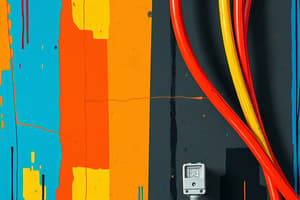Podcast
Questions and Answers
What is the main difference between standards and regulations?
What is the main difference between standards and regulations?
- Standards are voluntary, while regulations are legally binding (correct)
- Standards are created by organizations, while regulations are created by governments
- Standards provide guidelines, while regulations specify laws
- Standards are legally binding, while regulations are voluntary
Which organization is responsible for developing the 'IEEE Guide for Performing Arc Flash Calculations'?
Which organization is responsible for developing the 'IEEE Guide for Performing Arc Flash Calculations'?
- ISO
- ASTM International
- NCEES
- IEEE (correct)
What is the purpose of the ISO/IEC 17025:2017 standard?
What is the purpose of the ISO/IEC 17025:2017 standard?
- To specify methods for determining incident energy in electrical systems
- To provide guidelines for electrical engineering licensing exams
- To enforce compliance with electrical engineering standards
- To outline requirements for the competence of testing and calibration laboratories (correct)
What do licensing exams such as the FE and PE exams demonstrate?
What do licensing exams such as the FE and PE exams demonstrate?
Which activity is NOT a way to achieve compliance with electrical system requirements?
Which activity is NOT a way to achieve compliance with electrical system requirements?
Why is compliance with regulations, standards, and licensing requirements important in electrical engineering?
Why is compliance with regulations, standards, and licensing requirements important in electrical engineering?
What is the purpose of regulations in electrical engineering?
What is the purpose of regulations in electrical engineering?
Which organization publishes the National Electrical Code (NEC) in the United States?
Which organization publishes the National Electrical Code (NEC) in the United States?
What is the purpose of the National Electrical Safety Code (NESC)?
What is the purpose of the National Electrical Safety Code (NESC)?
How do states, provinces, or municipalities typically adopt the National Electrical Code (NEC)?
How do states, provinces, or municipalities typically adopt the National Electrical Code (NEC)?
Which directives outline safety and electromagnetic compatibility requirements in the European Union (EU)?
Which directives outline safety and electromagnetic compatibility requirements in the European Union (EU)?
What aspects do regulations, standards, and licensing requirements help ensure in electrical systems?
What aspects do regulations, standards, and licensing requirements help ensure in electrical systems?
Flashcards are hidden until you start studying
Study Notes
Electrical Engineering Law: Regulations, Standards, Licensing, Compliance
As electrical engineers design, develop, and deploy electrical systems to power our world, they must navigate a complex web of regulations, standards, and licensing requirements. This article will delve into these crucial aspects of electrical engineering law, explaining why they exist and how they ensure safety, efficiency, and effectiveness in electrical systems.
Regulations
Regulations are legal requirements established by government agencies to uphold public safety and protect the environment. At the federal level in the United States, the National Electrical Code (NEC), published by the National Fire Protection Association (NFPA), serves as a model code for electrical installations. States, provinces, or municipalities may adopt and amend the NEC to create their own codes. For instance, the National Electrical Safety Code (NESC) is a set of standards for electrical systems in communication, electric power generation, transmission, and distribution.
Similarly, countries worldwide have their own sets of regulations. For example, in the European Union (EU), the Low Voltage Directive (LVD) and the Electromagnetic Compatibility (EMC) Directive outline safety and electromagnetic compatibility requirements, respectively, for electrical equipment.
Standards
In contrast to regulations, which are legally binding, standards are voluntary technical specifications created by organizations like the IEEE, ASTM International, and the International Organization for Standardization (ISO). They provide guidelines for best practices and help ensure that electrical components, systems, and products meet specific requirements and perform consistently.
For example, IEEE 1584-2018, "IEEE Guide for Performing Arc Flash Calculations," specifies methods for determining the incident energy and flash protection boundaries for electrical systems. The ISO/IEC 17025:2017 standard outlines the general requirements for the competence of testing and calibration laboratories, including those that test electrical equipment.
Licensing Requirements
To practice electrical engineering safely and legally, many professionals must obtain a specific license from their jurisdiction's licensing board. In the United States, the National Council of Examiners for Engineering and Surveying (NCEES) develops and administers the Fundamentals of Engineering (FE) exam and the Professional Engineering (PE) exam. Passing these exams demonstrates that an engineer has a base of knowledge and understanding of electrical engineering principles.
Licensing requirements vary by state, and some states require electrical engineers to specialize in subfields such as communications, construction, or power. For example, in California, engineers must pass a state-specific exam to obtain a "C" license for general electrical contracting or a "D" license for electrical engineering.
Compliance
Ensuring that electrical systems and products adhere to regulations and standards is essential for their safety and effectiveness. Compliance with these requirements can be achieved in various ways, including:
- Designing and installing electrical systems according to established codes and standards
- Testing products to ensure they meet safety and performance requirements
- Maintaining, inspecting, and repairing electrical systems to prevent hazards
- Keeping up to date with changes in regulations, standards, and technology
Compliance is critical because it helps prevent accidents, ensures that products are safe for use, and promotes a consistent level of quality in electrical systems.
As electrical engineers navigate the complex landscape of regulations, standards, and licensing requirements, they must be committed to continued learning and professional development. By adhering to these guidelines, they can help ensure that electrical systems are safe, effective, and meet the needs of those who rely on them.
Studying That Suits You
Use AI to generate personalized quizzes and flashcards to suit your learning preferences.



